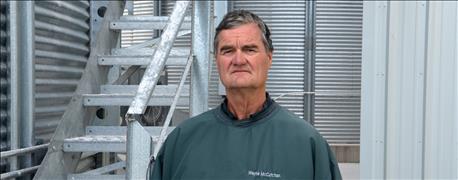
Perhaps deciding to build grain bins and store on the farm seems like a no-brainer. It may not be as open and shut as it sounds. Wayne McCutchan is just one of several farmers who ran a profitable, well-managed farm without any on-farm grain storage for years.
In fact, McCutchan was named an Indiana Prairie Farmer Master Farmer in 1993. At the time, he didn’t store any grain on the farm. Today, he does.
So what changed? Why did it make sense not to invest in bins for drying and storing grain 20 years ago? Why did it make sense to change course and build storage?
The case for no on-farm storage

WHEN STORAGE PAYS: Wayne McCutchan was a good manager when he didn’t store any grain on the farm. He’s still a good manager, partly because he recognized when to build storage.
“We ran six to seven semitrucks then,” McCutchan begins. "In the 1980s we could usually keep the combine running by hauling straight to elevators. We didn’t have much downtime at first waiting for trucks to get back.
“Since we hadn’t invested in grain bins, it helped some when things were tight in the early 1980s,” he recalls. “We ran two eight-row combines by then and could keep up.”
Just because he didn’t store grain doesn’t mean McCutchan didn’t pay attention to grain marketing. “I did a lot of forward-selling,” he says. “That helped me get a price most of the time that was profitable.”
So what changed locally that impacted how McCutchan approached harvesting and marketing grain?
“In general, some elevators didn’t keep pace with the times as the 1980s went along,” he notes. “Lines got longer to dump, making it take longer to turn a truck around.”
Perhaps the biggest thing, however, was the opportunity created by new markets. “Ethanol plants opened up in the '90s,” he relates. Multiple plants are in easy driving distance for McCutchan. Ethanol plants need corn and will bid up for it when necessary.
“One factor was that ethanol plants don’t tend to build a lot of storage on-site,” he says. “One of the plants we began selling to only had about two to three weeks of storage on-site. Yet they needed corn all year long.”
Courage to change
Study the history of nearly every Master Farmer, and somewhere along the way they had the courage to make a major decision which would impact their farming operation in the future. Most recently, Dan Gwin, Linden, just named a 2016 Master Farmer, switched from specialty white corn to all commercial yellow corn this year, primarily because market dynamics changed. The Master Farmer award is co-sponsored by the Purdue University College of Agriculture.
McCutchan had the courage to begin investing in grain bins, seeing the opportunity to take advantage of new markets. “We started building grain bins in the '90s, and we’ve added more as necessary,” he says. Today, the vast majority of their grain is stored on-farm. Some of it goes to a neighboring elevator that ships corn for feeding. But the ethanol plants were key in making markets more competitive in his area.
About the Author(s)
You May Also Like




